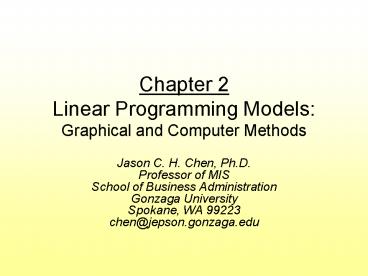Chapter 2 Linear Programming Models: Graphical and Computer Methods - PowerPoint PPT Presentation
1 / 28
Title:
Chapter 2 Linear Programming Models: Graphical and Computer Methods
Description:
Chapter 2 Linear Programming Models: Graphical and Computer Methods – PowerPoint PPT presentation
Number of Views:248
Avg rating:3.0/5.0
Title: Chapter 2 Linear Programming Models: Graphical and Computer Methods
1
Chapter 2Linear Programming ModelsGraphical
and Computer Methods
- Jason C. H. Chen, Ph.D.
- Professor of MIS
- School of Business Administration
- Gonzaga University
- Spokane, WA 99223
- chen_at_jepson.gonzaga.edu
2
Steps in Developing a Linear Programming (LP)
Model
- Formulation
- Solution
- Interpretation and Sensitivity Analysis
3
Properties of LP Models
- Seek to minimize or maximize
- Include constraints or limitations
- There must be alternatives available
- All equations are linear
4
Example LP Model FormulationThe Product Mix
Problem
- Decision How much to make of gt 2 products?
- Objective Maximize profit
- Constraints Limited resources
5
Example Flair Furniture Co.
- Two products Chairs and Tables
- Decision How many of each to make this
month? - Objective Maximize profit
6
Flair Furniture Co. Data
- Other Limitations
- Make no more than 450 chairs
- Make at least 100 tables
7
- Decision Variables
- T Num. of tables to make
- C Num. of chairs to make
- Objective Function Maximize Profit
- Maximize 7 T 5 C
8
Constraints
- Have 2400 hours of carpentry time available
- 3 T 4 C lt 2400 (hours)
- Have 1000 hours of painting time available
- 2 T 1 C lt 1000 (hours)
9
- More Constraints
- Make no more than 450 chairs
- C lt 450 (num. chairs)
- Make at least 100 tables
- T gt 100 (num. tables)
- Nonnegativity
- Cannot make a negative number of chairs or tables
- T gt 0
- C gt 0
10
Model Summary
- Max 7T 5C (profit)
- Subject to the constraints
- 3T 4C lt 2400 (carpentry hrs)
- 2T 1C lt 1000 (painting hrs)
- C lt 450 (max chairs)
- T gt 100 (min tables)
- T, C gt 0 (nonnegativity)
11
Using Excels Solver for LP
- Recall the Flair Furniture Example
- Max 7T 5C (profit)
- Subject to the constraints
- 3T 4C lt 2400 (carpentry hrs)
- 2T 1C lt 1000 (painting hrs)
- C lt 450 (max chairs)
- T gt 100 (min tables)
- T, C gt 0 (nonnegativity)
- Go to file 2-1.xls
12
(No Transcript)
13
(No Transcript)
14
Add a new constraint
- A new constraint specified by the marketing
department. - Specifically, they needed to ensure theat the
number of chairs made this month is at least 75
more than the number of tables made. The
constraint is expressed as
C - T gt 75
15
Revised Model for Flair Furniture
- Max 7T 5C (profit)
- Subject to the constraints
- 3T 4C lt 2400 (carpentry hrs)
- 2T 1C lt 1000 (painting hrs)
- C lt 450 (max chairs)
- T gt 100 (min tables)
- - 1T 1C gt 75
- T, C gt 0 (nonnegativity)
- Go to file 2-2.xls
16
(No Transcript)
17
End of Chapter 2
- No Graphical Solution will be discussed
18
Graphical Solution
- Graphing an LP model helps provide insight into
LP models and their solutions. - While this can only be done in two dimensions,
the same properties apply to all LP models and
solutions.
19
C 600 0
Carpentry Constraint Line 3T 4C
2400 Intercepts (T 0, C 600) (T 800, C 0)
Infeasible gt 2400 hrs
3T 4C 2400
Feasible lt 2400 hrs
0 800 T
20
C 1000 600 0
Painting Constraint Line 2T 1C
1000 Intercepts (T 0, C 1000) (T 500, C
0)
2T 1C 1000
0 500 800 T
21
C 1000 600 450 0
Max Chair Line C 450 Min Table Line T 100
Feasible Region
0 100 500 800 T
22
C 500 400 300 200 100 0
Objective Function Line 7T 5C Profit
7T 5C 4,040
Optimal Point (T 320, C 360)
7T 5C 2,800
7T 5C 2,100
0 100 200 300 400
500 T
23
C 500 400 300 200 100 0
Additional Constraint Need at least 75 more
chairs than tables C gt T 75 Or C T gt 75
New optimal point T 300, C 375
T 320 C 360 No longer feasible
0 100 200 300 400
500 T
24
LP Characteristics
- Feasible Region The set of points that
satisfies all constraints - Corner Point Property An optimal solution must
lie at one or more corner points - Optimal Solution The corner point with the best
objective function value is optimal
25
Special Situation in LP
- Redundant Constraints - do not affect the
feasible region - Example x lt 10
- x lt 12
- The second constraint is redundant because it is
less restrictive.
26
Special Situation in LP
- Infeasibility when no feasible solution exists
(there is no feasible region) - Example x lt 10
- x gt 15
27
Special Situation in LP
- Alternate Optimal Solutions when there is more
than one optimal solution
C 10 6 0
Max 2T 2C Subject to T C lt 10 T lt
5 C lt 6 T, C gt 0
All points on Red segment are optimal
2T 2C 20
0 5 10 T
28
Special Situation in LP
- Unbounded Solutions when nothing prevents the
solution from becoming infinitely large
C 2 1 0
Direction of solution
Max 2T 2C Subject to 2T 3C gt 6 T,
C gt 0
0 1 2 3 T































